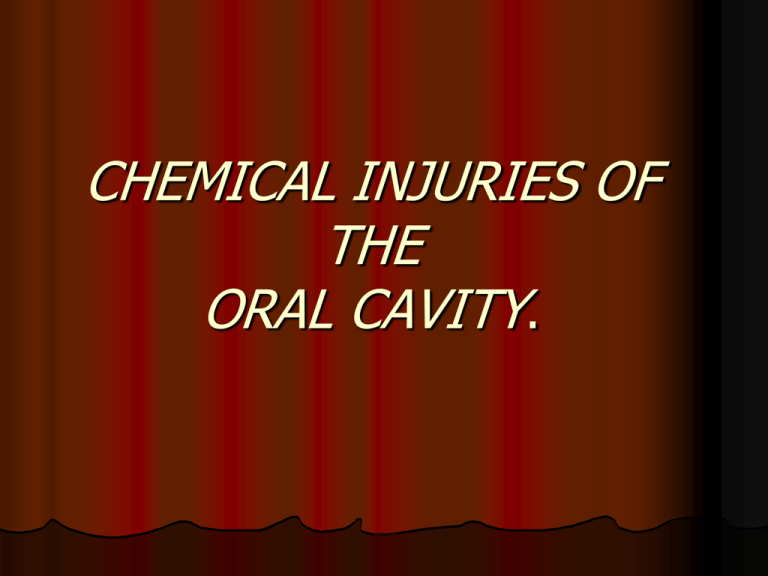chemical injuries
advertisement

CHEMICAL INJURIES OF THE ORAL CAVITY. CHEMICAL INJURIES OF THE ORAL CAVITY The oral cavity frequently manifests a serious reaction to a wide variety of drugs and chemicals. The tissue reaction is that of a local response to a severe irritant or even a caustic used injudiciously. Contd…. Allergic phenomenon is the most common reactions to drugs or chemicals. The two main types that are of dental interest are: 1.Drug allergy or stomatitis 2.Contact stomatitis NONALLERGIC REACTION TO DRUGS AND CHEMICALS USED LOCALLY. Irritants or caustics which are used by the dentist in various therapeutic are technical procedures induces a non allergic reactions when used locally. Some of these substances are discussed separately below: 1.Aspirin (Acetylsalicylic Acid) 2.Endodontic Materials. Contd…. 2. Sodium Perborate. 3.Hydrogen Peroxide. 4. Phenol. 5.Silver Nitrate. 6. Trichloroacetic Acid. 7. Volatile Oils. 8. Miscellaneous Drugs and chemicals. ASPIRIN (ACETYLASALICYLIC ACID) Uses: It is especially used for the relief of toothache. Effects: Particularly harmful to the oral mucosa if applied locally. Separation and sloughing of the epithelium and frequently bleeding. ASPIRIN BURNS ASPIRIN BURNS Endodontic materials Effects: Dangerous to oral soft tissues. Damage or deep spread of inflammation and necrosis if injected into hard tissues. Examples: Paraformaldehyde,sodium hypochlorite, hydrogen peroxide etc. Sodium Perborate Uses: Used as a mouth-wash and in dentrifices. Effects: Produced an erythema of the oral mucosa. Sloughing of the tissues. Hydrogen peroxide Uses: Prevention of periodontitis. Effects: Epithelial necrosis. Sloughing of the epithelium. PHENOL Uses: Cavity sterilizing agent. Cauterizing agent. Effects: Severe painful burns of the oral mucosa and skin. DENTAL STAIN DUE TO LONG TERM USE OF CHLORHEXIDINE MOUTHWASH Volatile oils Effects: Produce mild burns of the mucous membranes. Examples: Oil of cloves. Oil of winter green. Eucalyptus oil. TETRACYCLINE Effects: Discoloration of deciduous or permanent teeth. Affinity for deposition in bones and tooth substance. Moffitt’s contributions: Critical period for tetracycline induce discoloration in the deciduous dentition is: 1. 4 months in utero. 2. 3 months in postpartum for maxillary and mandibular incisor. Contd.. 3. 5 months in utero to 9 months postpartum for maxillary and mandibular canines. 4. 3 to 5 months postpartum is necessary for permanent maxillary and mandibular incisor and canines. Grossman’s contribution: tetracycline therapy diminishes tooth discoloration if its indicated in the pregnant female or during 6 to 7 yrs of life. TETRACYCLINE STAIN OF MANDIBULAR TEETH MINOCYCLINE-ASSOCIATED PIGMENTATION Contd.. Clinical features: Tetracycline 1. Yellowish or brownish-gray diffuse bands of discoloration within the tooth structure. 2. Fluoresces under ultra violet light. Chlorotetracycline 1. brownish gray colour within the tooth structure. Contd.. Minocycline hydrochloride 1. commonly stained in skin, nails, sclera, conjunctiva, thyroid, bones and teeth. 2. dark colour of underlying bone through the thin translucent oral mucosa. 3. reveal varying patterns of discoloration. Cancer chemotherapeutic agent Groups of drugs and agents, used for the treatment of malignant neoplastic diseases. Function: - Destruction of malignant cells. Cytotoxic agent exert their effect preferentially against mitotic cells. Side effect: - Normal mitotic cells of oral mucosa, bone marrow and skin are also prone to the cytotoxic and damaging effect of these agents. Contd.. Clinical features: - few general manifestations of these agents due to their non specific nature: 1. Alopecia. 2. Stomatitis. 3. Radiation recall or radiation sensitisation. Contd.. Oral manifestations: 1. mucosal erosion and ulceration in the mouth, frequently diffuse and multiple, often related to neutropenia. 2. haemorrhage resulting from thrombocytopenia. 3.hyper pigmentation of oral mucosa. Contd.. Treatment: - No specific treatment for the oral lesions which although severe, must be considered, of only secondary importance to the patient’s major problem.







